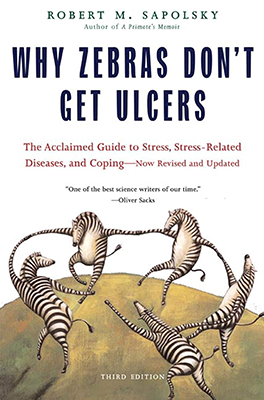Why Zebras Don’t Get Ulcers
“Why Zebras Don’t Get Ulcers” is a book written by Robert M. Sapolsky, a renowned neuroscientist and primatologist, first published in 1994 and updated in subsequent editions. In this book, Sapolsky explores the fascinating interplay between stress and the human body, drawing on his own research and experiences studying stress in animals, particularly primates, as well as insights from neuroscience, physiology, and psychology.
The central premise of the book is that while stress is a natural and adaptive response that helps animals survive in threatening situations, chronic stress can have serious consequences for physical and mental health. Sapolsky explains how the stress response evolved as a survival mechanism, triggering a cascade of physiological changes that prepare the body to confront or flee from danger.
However, in modern society, many of the stressors humans face are chronic and psychological rather than acute and physical. Sapolsky discusses how prolonged stress can disrupt the body’s systems, leading to a wide range of health problems, including cardiovascular disease, immune dysfunction, and mental illness.
Throughout the book, Sapolsky explores the biological mechanisms underlying the stress response, explaining how hormones such as cortisol and adrenaline affect various organs and systems in the body. He also examines the ways in which stress can impact behavior, cognition, and emotions, influencing everything from decision-making to social interactions.
Despite the grim picture painted by the book, Sapolsky offers hope by discussing strategies for managing stress and mitigating its effects on health. He emphasizes the importance of social support, exercise, relaxation techniques, and other coping mechanisms in promoting resilience and well-being.
Overall, “Why Zebras Don’t Get Ulcers” is a comprehensive and engaging exploration of the science of stress, offering valuable insights into the complex relationship between mind and body. Sapolsky’s accessible writing style, combined with his deep expertise in neuroscience and biology, makes this book a must-read for anyone interested in understanding the impact of stress on human health and behavior.

